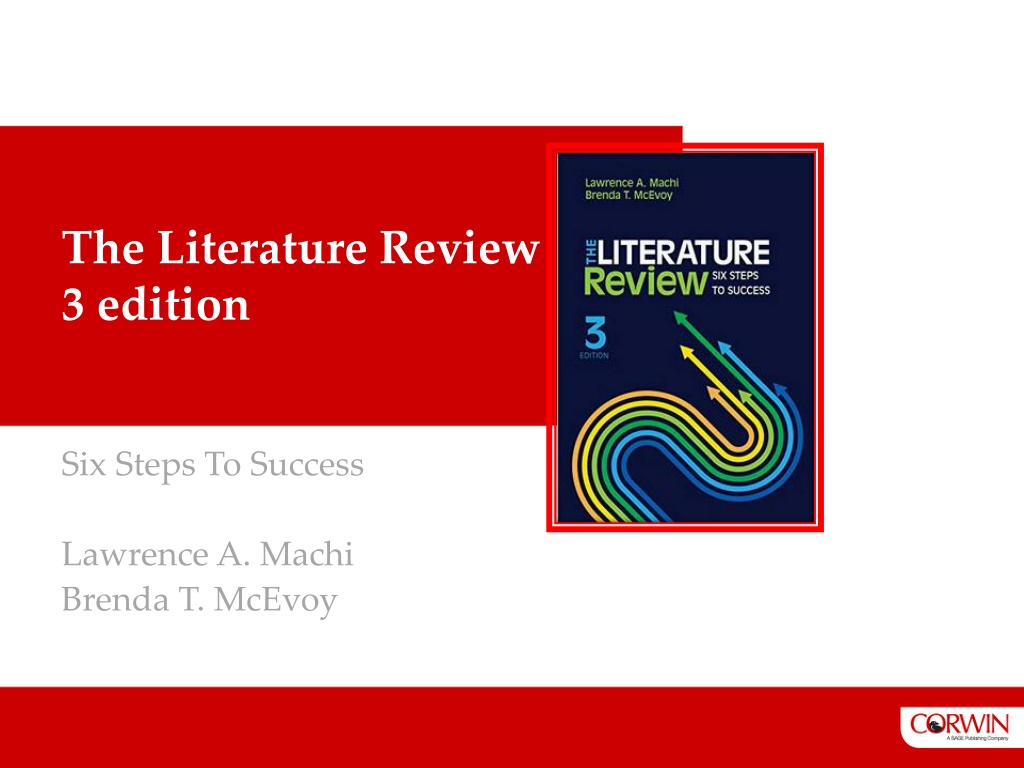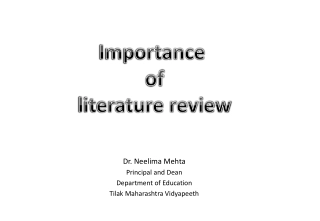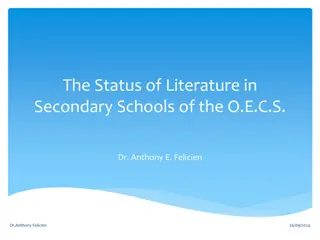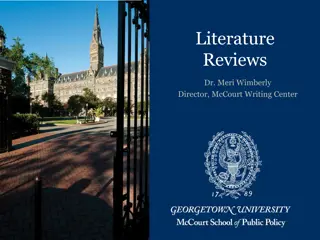Mastering the Literature Review Process: Essential Steps for Success
Understanding the essence of a literature review and its importance in academic research is crucial. This guidebook explores the key steps involved in conducting a literature review effectively, from defining the research topic to communicating and evaluating conclusions. It emphasizes critical thinking, problem-solving, and argumentation skills necessary for producing a thorough and compelling review.
Uploaded on Oct 03, 2024 | 0 Views
Download Presentation

Please find below an Image/Link to download the presentation.
The content on the website is provided AS IS for your information and personal use only. It may not be sold, licensed, or shared on other websites without obtaining consent from the author. Download presentation by click this link. If you encounter any issues during the download, it is possible that the publisher has removed the file from their server.
E N D
Presentation Transcript
The Literature Review 3 edition Six Steps To Success Lawrence A. Machi Brenda T. McEvoy
Introduction Doing and Producing a Literature Review An Overview
The Literature Review Defined A literature review is a written document that presents a logically argued case founded on a comprehensive understanding of the current state of knowledge about a topic of study. This case establishes a convincing thesis to answer the study s question.
Research Interest Answers Identifies Research Thesis Research Topic Specifies and frames Discovers and advocates Literature Review Figure I.1
Research Interest Answers Identifies Research Project Research Topic Determines nature and scope Specifies and frames Research Question Literature Review Research Thesis Defines further research Discovers and advocates Figure I.2
6. Communicate and evaluate the conclusions 1. Recognize and define a problem 1. 6. Select a Topic Write the Thesis Doing a Literature Review is scholarly exercise employing an applied critical thinking process. 5. Critique the Literature 2. Develop Tools of Argumentation 5. Draw conclusions 2. Create a process for solving the problem 3. 4. Search the Literature Survey the Literature 4. Discover the evidence and build the argument 3. Collect and compile information Figure I.3
1. Select a Topic Addresses and answers Specifies 6. 2. Write the Thesis Develop Tools of Argumentation Organizes and forms Advocates and defines 5. 3. Critique the Literature Search the Literature Documents and discovers 4. Explores and catalogs Survey the Literature Figure I.4
Inquisitive Skeptical Intellectual Disposition s Independent Honest Mindset How I Choose to Be and Act. Decision- Making Dispositions Action Dispositions Reasoned and logical thinking Persistence Patience Circumspect thinking Deliberation Collegiality Figure I.5
Self-Regulation Self-Correction Quality control of your thinking process. Reflecting on and monitoring your work procedures and thinking processes. Checking the accuracy and validity of the work The reflective thinker reviews the work and thinking being done, and corrects deficiencies. What I do? How did it work? What do I do next? Self-Assessment Reflecting on your analytical reasoning. Reflecting on factors constraining your accuracy , objectivity, and rationality. Reflecting on your mindset influences a fair and unbiased interpretation of the project work. Reflective Oversight
The Ethics of Scholarly Work Do not take data out of context. Do your own research. Present only what you believe to be factual. Present all sides of the question. Plagiarism can easily sneak into a review unless it is carefully avoided. You must be the sole writer of your literature review.
Pack Wisely Before You Begin First, as a reviewer, you should organize a workspace free from distractions. You will also need, Minimally, at least one high-quality dictionary and thesaurus. Reference works on research methods and writing skills can also be useful. As with any complex project, the literature review demands concentrated mental focus. Having a plan increases productivity. Develop a three-level plan. First, create an overall project plan and timeline. Second, subdivide the overall plan into sections that act as intermediate goals for the project. Finally, build daily plans from the subsections to schedule the work for each daily session.
Tips Study carefully the literature review model. Memorize it if possible. Use this flow chart to keep yourself on track. Select a topic that is important to you. A subject of true concern or curiosity will produce better work than a topic chosen for expediency. Writing starts now! Journal ideas, questions, and your current understanding of the material. Develop a project journal to catalog your work and reflective thought as you work. Plan every step. Going back to pick up missed steps takes far more time.

 undefined
undefined
 undefined
undefined






















